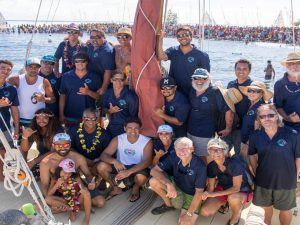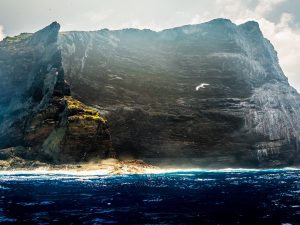While sailing up the East Coast in the spring of 2016, ʻImiloa Astronomy Center and the Polynesian Voyaging Society took the opportunity to collaborate with noted museums, science centers, and planetariums to celebrate Hawaiʻi’s traditional knowledge around this voyage.
“For the Smithsonian, we are a platform that wants to bring in the cultural experts who can really bring these stories to life. That’s not us, it’s people like the scientist at ʻImiloa or the people who are on the voyage with the Hōkūleʻa. They just have these amazing people with such amazing stories to share with us,” expresses Hayes Lavis, Cultural Arts Curator at The National Museum of American Indian in Washington D.C.
Similarly, Michael Shara, Curator of Astrophysics at the American Museum of Natural History in New York notes, “Why is it important to share the knowledge of explorers worldwide and in particular the Polynesian explorers from the past 2,000 years? One is the beauty of what they did and the magnificence of what they did. You don’t need that kind of detailed ‘physics knowledge,’ which only comes with having telescopes, to be able to use the stars in very practical means to navigate the globe. And that was incredibly brave, fore-sighted, and I think encompasses the best of humanity.”
Hōkūleʻa Captain and Master Navigator, Kālepa Baybayan shares that, “It takes collaboration from many different people. The Polynesian Voyaging Society is just a volunteer organization. ʻImiloa is a cohesive unit that is trying to execute its educational mission. But it’s all the different partners coming together underneath a single umbrella to host a conversation about our voyaging traditions that makes this effort collaborative but also very successful and very compelling in this nature of this story that we are trying to share.”
Collaborating with these science centers and museums introduced a whole new audience to this traditional knowledge of voyaging and wayfinding.
“I think this is probably a very different audience compared to what they are going to be encountering elsewhere. So it’s a good chance to really help to educate people who don’t know anything really about Hawaiʻi other than what they see when they go to a tourist show. So this is the real Hawaiʻi. It gives them a chance to really learn and I think it gives both the educators and the audience here an amazing opportunity,” says Lavis.
Kumu Hula and Musician, Robert Cazimero, confirms this idea in stating that they came, “To really showcase the beauty of Hawaiian culture, arts, and ingenuity – and what better way to do so than by celebrating Hōkūleʻa and her worldwide voyage. We are here to teach people from around the world about Hawaiʻi and our culture, which I think is really important to the longevity of our Hawaiian culture.”
These partnerships help to not only share the beauty of Hawaiian culture, but also the scientific brilliance of Polynesian wayfinders and the Worldwide Voyage’s amazing mission of “Mālama Honua,” to care for Island Earth.




